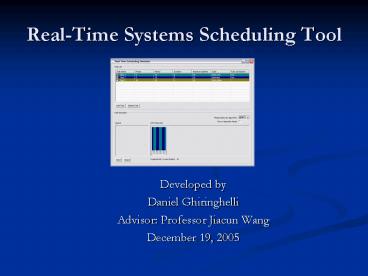RealTime Systems Scheduling Tool - PowerPoint PPT Presentation
1 / 19
Title:
RealTime Systems Scheduling Tool
Description:
Clock driven / Round-robin /Priority-driven. Need a tool to illustrate how these algorithms work ... EDF and DM Example. T1. T2. T1. T2 (a) EDF (b) RM. 3. 6. 9 ... – PowerPoint PPT presentation
Number of Views:98
Avg rating:3.0/5.0
Title: RealTime Systems Scheduling Tool
1
Real-Time Systems Scheduling Tool
- Developed by
- Daniel Ghiringhelli
- Advisor Professor Jiacun Wang
- December 19, 2005
2
Overview
- Motivation
- Features
- Platform and Tools
- Software Engineering Approach
- Algorithm Overview (bonus included!)
- Tool Design (30,000 ft. view)
- Tool Overview and Demonstration
- Summary
3
Motivation
- Real-time systems time critical systems
- Schedule assignment of jobs to available
processors - Feasible schedule every job completes by its
deadline - Scheduling algorithms
- Clock driven / Round-robin /Priority-driven
- Need a tool to illustrate how these algorithms
work - Particularly in RTS classes
- and find feasible schedules
- Helpful for research
4
Features
- Common Priority-Driven Algorithm Support
- Earliest Deadline First
- Deadline Monotonic
- Least Slack First
- Hyperperiod calculation
- Extendable interface
- Simulations based on task specifications
- Graphical user interface
- Task management
- Visualization of a dynamic scheduler
5
Platform and Tools
- Written in Java
- Eclipse 3.0 IDE
- SWT GUI library
- Deployed as an executable JAR
Integrated JUnit Testing
6
Software Engineering Principles
- Informal process
- Frequent Releases
- GUI Mock-up
- Test Driven
- Regression TestPolicy
Initial Mock-up
7
Software Engineering Approach
- Lightweight V-Model approach
- Essentially a waterfall but with User Involvement
- No system testing (i.e., Lightweight)
- Test Driven
- UAT written during Requirements
- Unit Tests written during detailed design and
construction - Customer Checkpoints
8
Lightweight V-Model
9
Algorithms Overview DM
- Deadline Monotonic (DM)
- Static fixed priority scheduler
- Immediately pre-empts any running task with a
higher priority task - Advantages
- Easy to implement (most widely used)
- Low system overhead
- Disadvantages
- Not optimal
- Requires static prioritization before run-time
10
Algorithm Overview EDF
- Earliest Deadline First (EDF)
- Dynamic priority scheduler
- Highest priority is assigned to the task with the
nearest deadline - Advantages
- EDF theoretically superior to DM
- Guaranteed scheduleability if CPU utilization
100 or less - Disadvantages
- More difficult to implement
- Higher system overhead
- Overloaded system is unpredictable (non-critical
tasks may be scheduled before critical tasks)
11
Algorithm Overview LSTF (bonus!)
- Least Slack Time First (LSTF)
- Dynamic priority scheduler
- Highest priority given to the task with the least
slack time (timeToDeadline executionTimeLeft) - Advantages
- Same as EDF
- Intuitively logical
- Disadvantages
- Same as EDF
12
EDF and DM Example
T1(0, 5, 3, 5), T2(0, 3, 1, 3)
13
RTS Scheduling Tool Design
- MVC Architecture
- Controlling thread polls simulation thread for
model updates
14
RTS Scheduling Tool Package View
15
Thread Interaction
16
Simulator Internals
17
Tool Overview Demo
18
Concluding Remarks
- RTS Scheduling Tool features
- Friendly UI
- Effective teaching tool
- Scheduleability analysis
- Work to be done
- Additional algorithms can be easily added!
- GUI features and options
19
Acknowledgments
- MU Software Engineering Faculty
- Professor Wang
- Professor McDonald































